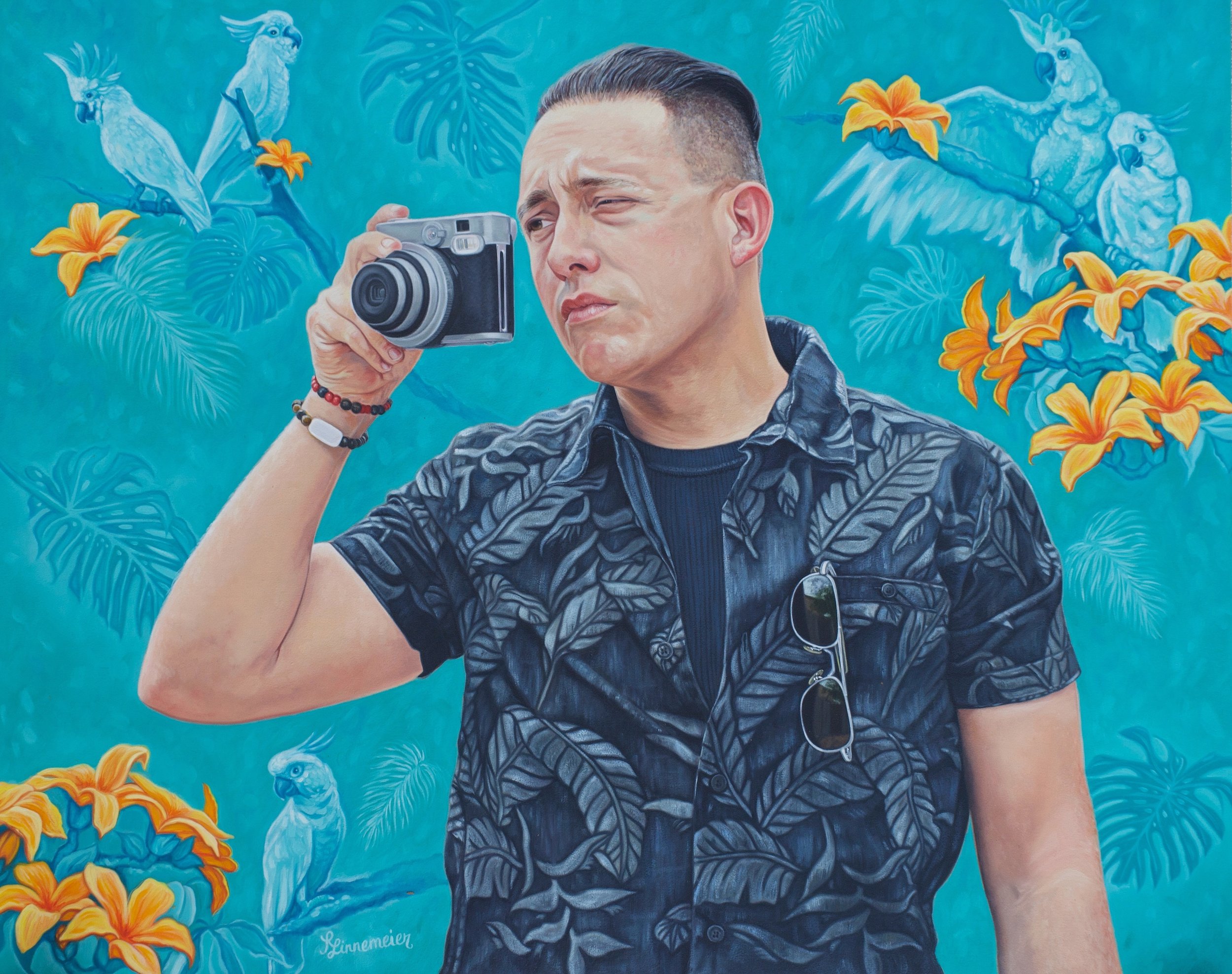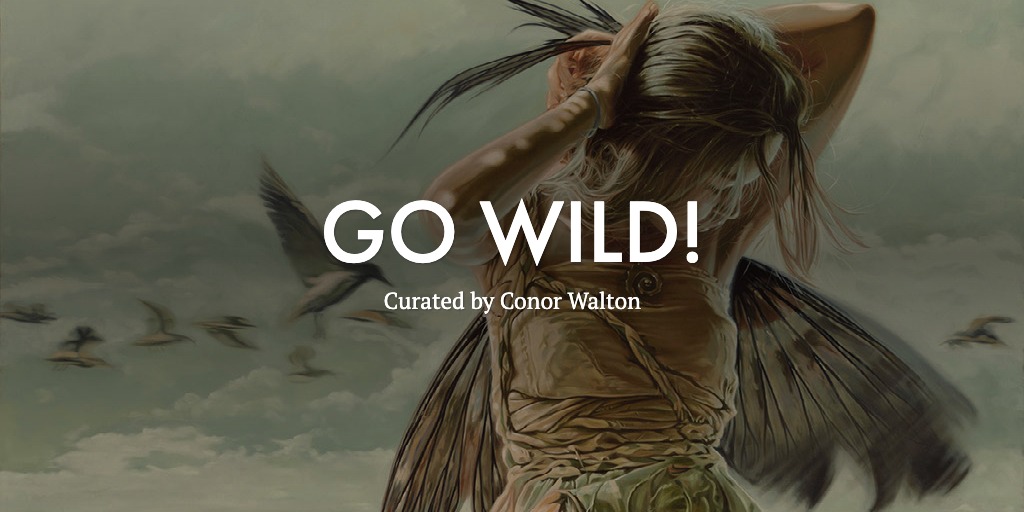The human figure is easily the most relatable of fine art subjects, but it is also easily the most complex. That complexity is not just from learning how to accurately paint the human anatomy, but also in deciding how to convey the emotion, life and experience of the figure to fit the composition. Add to that an artist’s individual style—ranging from conveying all the details to fixating on the atmosphere—and you have a multitude of elements that bring the image to life.
In the annual Painting the Figure Now exhibition, presented by PoetsArtists at the Wausau Museum of Contemporary Art, the human experience is on full display. This year’s show, happening July 7 through October 2, is guest curated by art collector Dr. Samuel Peralta who says the addition of Now to the title is the true anchor and theme of the show.
“Figure painting has a long and historical tradition—but for these series of exhibits, the art has to have a perspective that’s contemporary, compelling and current,” says Peralta. “The PTFN series present Polaroids in brushstrokes, as it were, of the human condition Now.”
In selecting the just under three dozen works, Peralta turned to works with a symbolic undercurrent or narrative that allow the viewer to explore the painting. “Including this doesn’t have to be an overt or conscious process—it can emerge subconsciously during composition and be available to be inferred from the finished piece,” he explains. “For me, the question to ask was: Was the artist successful in conveying that intention to me through their portrayal of the human figure?”
What resulted is a show that demonstrates, for Peralta, that work with “the vocabulary of modern accoutrements remains true to its historical, even classical, traditions.” Many of the artists with paintings in the show have atelier training where life drawing and painting classes were at the core of their curricula. Or they take inspiration from great masters—past and present—but with an eye for the contemporary world in which they are living. And, perhaps, something that should be noted is the paintings of the past were once present too.
There are some artists participating, such as Megan Elizabeth Read, who are outside of the box and didn’t grow up surrounded by the arts or have formal training. Instead, their own work has been an evolution through time and experience.
Read says, “I was always drawn to figurative work as a child; it was really the only thing that interested me and since I have no formal training or background in the arts it made sense when I began creating my own work I would simply gravitate toward the type of imagery I was most moved by.” From a technical standpoint, Read’s artwork has become more simplistic over time and she leans into a minimalistic approach to the materials that helps manage her process.
“More importantly, this need for reduced ‘noise’ and chaos in my real life is directly reflected in my paintings in that they tend to contain large canvases and are generally fairly simple compositionally,” she explains. “There is a lot of room to breathe there and creating these spaces helps me feel less fragmented. Less pull in too many directions. It’s like I am painting away the clutter and chaos.”
Since she started painting, Read has evolved the narrative in her artwork but has found some themes to weave their way through her oeuvre such as “the search for identity and the concept of constructed identities, the need for and fear of vulnerability, and this idea of multiple selves.”
Her work in the show, Nobody Showed Me Which Way to Go, plays into the themes because the work is about “the loneliness and confusion of being dropped into this world without a map or support system and the struggle to find one’s way under these conditions. About dragging yourself along amidst the beauty and terror we are faced with every day,” Read shares. The imagery comes from her personal experience of this feeling this. Growing up she was surrounded by cows, and sees herself reflected in them, so they are a nod to constructed identity and figuring out how to move through life.
Annie Louise Goldman is a young artist at the start of her career, and what direction she will take is still unfolding, but for now a passion for the figure has propelled her to new discoveries. Growing up Goldman did family portraits, and at age 13 she wanted to take a life drawing class. She enrolled in an art school in San Carlos, California, which she attended until she was 17 studying under artists such as Noah Buchanan.
“I learned about Baroque painting from Noah, and when I started was really fixated on composition, lighting and drama,” she says. “I also was doing Bard copies in a very 19th-century academic style. That’s been really influential as over the last couple of years I’ve started to explore a more contemporary side of art such as the work of Florine Stettheimer and Alice Neel.”
As a student currently at Laguna College of Art + Design, Goldman has started to develop narratives that are connected to her experiences. They are often very intimate narratives, and that’s reflected in how she approaches her work. Everything she does is derived from life drawing, but to get the right composition she will now take photos of her models, who are usually also friends. The narrative can come to life as she’s photographing, or there are times Goldman has a fully developed idea before the shoot starts.
In most of her work, Goldman wants to show the connection people have with one another. Her selected painting, Playtime, is an intimate moment of a couple undressing one another. Goldman says, “At the time we took the photos, the two women were a couple,” says Goldman, “so I was able to capture an intimate moment. The title reflects the innocent looking image, but it has sexual undertones…it isn’t portraiture or about specific people. It’s meant to reflect however the viewer is coming at the image.”
The idea that classical figurative imagery can hang next to any interpretation of the figure in exhibitions today is something that artist Chris Cart says allows artists to have more freedom in expression. This can come back to the figure itself, because instead of having a tight, classical image, the artist can interpret the mood or emotion in the way that suits the composition.
Cart’s work In the Waters eloquently combines multiple figures in a surrealistic move among the waves. The painting, which he says is about love, community, mindfulness and life as a dance, was started over a decade ago as a tightly rendered naturalistic piece, that was sanded down and repainted several times. The “blue lady” came in early, and maybe at first was subconsciously what Cart needed to experiment with the artistic process. A while ago he began to play with using multiple styles in one canvas and created what he calls “mashups in paint.” In the Waters as a result is a harmonious intertwining in composition and style.
“To me, artist has always meant depicting life as I see it around me,” says Anna Cyan. “Painting the Figure Now is in some ways about building a bridge across time—drawing on the long history of showing the body through paint but using this language to examine the here and now. Painting is a dialogue, not just with the past, but also with the future.”
Vulnerability is a theme that often appears in Cyan’s artwork, but this spring it came into focus on an even greater level and as a reflection of the present. “I am from Ukraine, and as I worked on the painting [that’s in the show], war coverage brought home how fragile the human body is, and the immensity of violence and destruction that can threaten it,” Cyan explains. “Initially, the painting was going to have a much lighter sky, but as the war unfolded, smoke started creeping in, and the overall tonal range got darker. So now the painting is called Smoke. When I look at it, the sound of air raid sirens plays in my mind, and it’s as though the character hears them too, in her world. They are distant, but there.”
Erica Calardo sees the exhibition as a chance to focus on the greater reawakening in the art world to relearn how to depict the figure—using Old Master techniques and skill, but painting for our times. Calardo shares the initial sentiment of the figure being “the most challenging subject within representational arts. Both technically and theoretically.” For her, reflecting humans in a realistic rather than idealized manner is important.
Reverie is Calardo’s first painting of a male figure and she wanted to depict him more than just as muscular and grand, full of physical strength and power.” Instead, the work is about intimacy and dreams, showing the man as someone who can have true and rich feelings. “My painting shows a person deep in dream and meditation, caught in his reverie,” she explains. “It is a very intimate and simple composition.”
Connecting to the “now” through modern fashion and topics is a highlight of Amy Gibson’s artwork. While always about the human condition, her most recent paintings focus on children and how they look at the world still with wonder and excitement. And it’s a reminder to the adult viewers to remember how they once saw the world as well.
Gibson’s painting They Said the Answer Was 42 is about technology and information overload for children today as they are exposed to news, social media and more at a fast rate. “That made me think back to the late 1980s when social media didn’t exist and I read a book called The Hitchhiker’s Guide to the Galaxy,” says Gibson. “The character was able to ask the all-knowing computer created by advanced aliens a question. He wanted to know the ultimate question of life, the universe and everything. The computer told him that the answer was 42. That left him even more confused. I feel like kids are feeling this way. They don’t know the questions to ask in order to filter through all of the chaos so they can actually find an answer. This is leaving them filled with anxiety and ambivalence.”
Each painting in the show condenses the theme by intimating a moment or expression of the human form. However, when viewed altogether, Painting the Figure Now “traverse[s] the range of emotional responses for each individual work” says Peralta. “We will see the gestural and expressionist range of the human face and body by seeing the collection as a whole.”
Along with the show at Wausau Museum of Contemporary Art, the works are available to purchase through 33 Contemporary’s Artsy page, and digitalized images will be included in a time capsule on the moon via Peralta’s Lunar Codex project.
“The Polaris time capsule will be launched via SpaceX Falcon Heavy rocket in 2023/24 and deposited on the Lunar South Pole via the Astrobotic Griffin lunar lander, which will also be carrying NASA’s VIPER rover to the moon,” says Peralta. “With the three time capsules of the Lunar Codex archiving art, writing, music and film from over 20,000 creatives from over 100 countries around the globe, the [PTFN 2022] artists will be joining the most expansive contemporary cultural exposition ever launched from Earth.”
About the Author
Rochelle Belsito is an experienced art writer and editor, having worked for International Artist Publishing for over 11 years in several positions. She served as managing editor for all five of the company’s titles for over seven years, and her most recent role was executive editor of American Art Collector, American Fine Art Magazine and International Artist. Currently she is a freelance contributing editor at Art & Antiques magazine and writes and edits for various other industries.
















